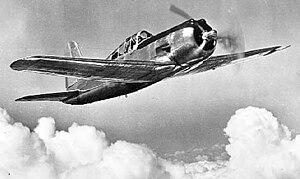P-66 Vanguard
| P-66 Vanguard | |
|---|---|
 |
|
| Vultee P-66 in flight. | |
| Role | Fighter |
| Manufacturer | Vultee Aircraft |
| Designer | Richard W. Palmer |
| First flight | 8 September 1939 (Model 61) |
| Introduction | 1941 (date shipment completed) |
| Retired | 1943 (USA) |
| Primary users |
United States Army Air Forces Chinese Nationalist Air Force |
| Produced | 1940–1942 |
| Number built | 146 |
The Vultee P-66 Vanguard was a United States Army Air Forces fighter aircraft. It was initially ordered by Sweden, but by the time the aircraft were ready for delivery in 1941, the United States would not allow them to be exported, designating them as P-66s and retaining them for defensive and training purposes. Eventually, a large number were sent to China where they were pressed into service as combat aircraft with indifferent results.
The Vultee Vanguard was the product of an idea conceived in the late 1930s by the Vultee Aircraft Division of the Aviation Manufacturing Corporation of developing four aircraft designed for different roles from a set of common wings and aft fuselage and tail assemblies. The company assigned four model designations: V-48 to a single-seat fighter, BC-51 to a basic combat trainer, B-54 to an advanced trainer, and BC-54D as a basic trainer. Eventually, the BC-51 would become the Army Air Corps BC-3 and the BC-54D, the BT-13.
In 1938, Richard W. Palmer started the detailed design of the V-48 fighter member of the quartet. The aircraft featured a metal-covered, semi-monocoque fuselage and fully retractable landing gear, and was powered by a Pratt & Whitney R-1830 air-cooled radial engine. During construction of the first prototype, a decision was made to lengthen the propeller shaft and install a tight cowling to provide a pointed nose to reduce drag. The first aircraft flew in September 1939 piloted by Vance Breese, and was assigned registration number NX21755. The fighter was named the Vanguard. On the 9th of May, 1940, the prototype collided with a Lockheed Sirius while landing at Vultee airfield, the impact severing one main undercarriage leg. Nevertheless Breese skillfully landed the aeroplane with little additional damage. It was subsequently rebuilt with the orthodox cowling as employed on subsequent machines.
Flight tests revealed the aircraft was suffering from inadequate cooling. Measures to modify the cooling ducting were of little avail. After re-evaluating the design, and noting that the insignificant drag decrease was not worth the added weight and ducting problems, the second prototype, which was assigned the model number V-48X and registration NX19999, was modified with a conventional cowl and the first aircraft were similarly modified. The second aircraft first flew on February 11, 1940. As a result of flight tests, a number of changes were made to the design including substantially increasing the areas of the horizontal and vertical tail surfaces.
...
Wikipedia
